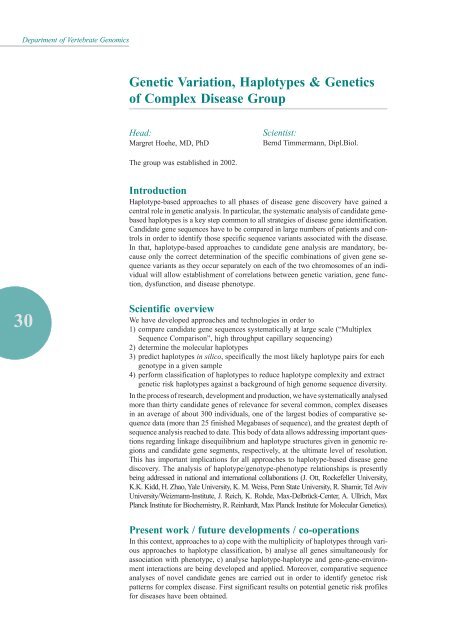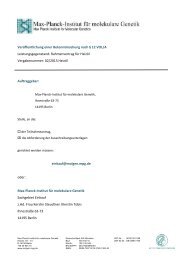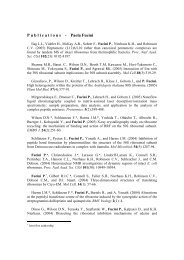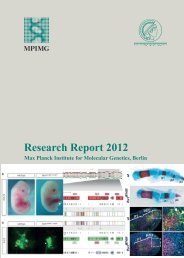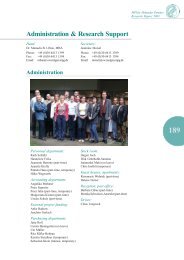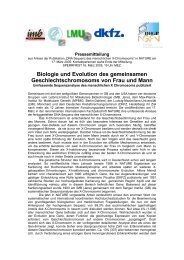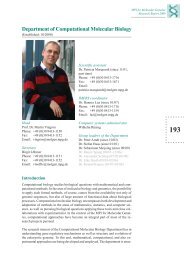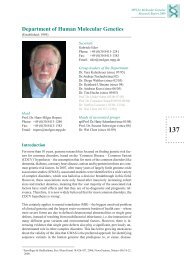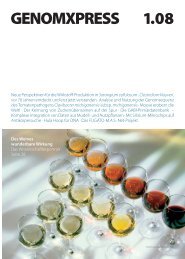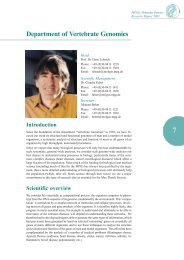Research Report 2003 - Max-Planck-Institut für molekulare Genetik
Research Report 2003 - Max-Planck-Institut für molekulare Genetik
Research Report 2003 - Max-Planck-Institut für molekulare Genetik
Create successful ePaper yourself
Turn your PDF publications into a flip-book with our unique Google optimized e-Paper software.
Department of Vertebrate Genomics<br />
30<br />
Genetic Variation, Haplotypes & Genetics<br />
of Complex Disease Group<br />
Head:<br />
Margret Hoehe, MD, PhD<br />
The group was established in 2002.<br />
Scientist:<br />
Bernd Timmermann, Dipl.Biol.<br />
Introduction<br />
Haplotype-based approaches to all phases of disease gene discovery have gained a<br />
central role in genetic analysis. In particular, the systematic analysis of candidate genebased<br />
haplotypes is a key step common to all strategies of disease gene identification.<br />
Candidate gene sequences have to be compared in large numbers of patients and controls<br />
in order to identify those specific sequence variants associated with the disease.<br />
In that, haplotype-based approaches to candidate gene analysis are mandatory, because<br />
only the correct determination of the specific combinations of given gene sequence<br />
variants as they occur separately on each of the two chromosomes of an individual<br />
will allow establishment of correlations between genetic variation, gene function,<br />
dysfunction, and disease phenotype.<br />
Scientific overview<br />
We have developed approaches and technologies in order to<br />
1) compare candidate gene sequences systematically at large scale (“Multiplex<br />
Sequence Comparison”, high throughput capillary sequencing)<br />
2) determine the molecular haplotypes<br />
3) predict haplotypes in silico, specifically the most likely haplotype pairs for each<br />
genotype in a given sample<br />
4) perform classification of haplotypes to reduce haplotype complexity and extract<br />
genetic risk haplotypes against a background of high genome sequence diversity.<br />
In the process of research, development and production, we have systematically analysed<br />
more than thirty candidate genes of relevance for several common, complex diseases<br />
in an average of about 300 individuals, one of the largest bodies of comparative sequence<br />
data (more than 25 finished Megabases of sequence), and the greatest depth of<br />
sequence analysis reached to date. This body of data allows addressing important questions<br />
regarding linkage disequilibrium and haplotype structures given in genomic regions<br />
and candidate gene segments, respectively, at the ultimate level of resolution.<br />
This has important implications for all approaches to haplotype-based disease gene<br />
discovery. The analysis of haplotype/genotype-phenotype relationships is presently<br />
being addressed in national and international collaborations (J. Ott, Rockefeller University,<br />
K.K. Kidd, H. Zhao, Yale University, K. M. Weiss, Penn State University, R. Shamir, Tel Aviv<br />
University/Weizmann-<strong>Institut</strong>e, J. Reich, K. Rohde, <strong>Max</strong>-Delbrück-Center, A. Ullrich, <strong>Max</strong><br />
<strong>Planck</strong> <strong>Institut</strong>e for Biochemistry, R. Reinhardt, <strong>Max</strong> <strong>Planck</strong> <strong>Institut</strong>e for Molecular Genetics).<br />
Present work / future developments / co-operations<br />
In this context, approaches to a) cope with the multiplicity of haplotypes through various<br />
approaches to haplotype classification, b) analyse all genes simultaneously for<br />
association with phenotype, c) analyse haplotype-haplotype and gene-gene-environment<br />
interactions are being developed and applied. Moreover, comparative sequence<br />
analyses of novel candidate genes are carried out in order to identify genetoc risk<br />
patterns for complex disease. First significant results on potential genetic risk profiles<br />
for diseases have been obtained.


